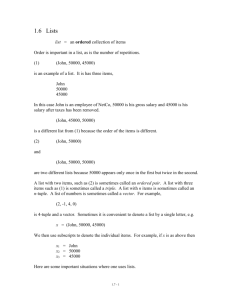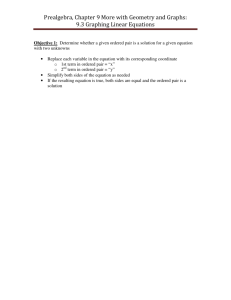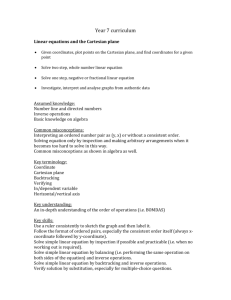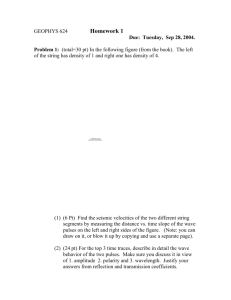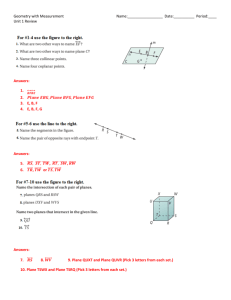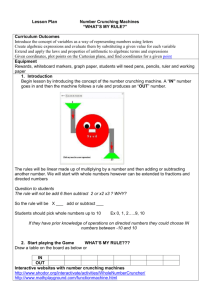Algebra II: Distance Formula Lesson Plan
advertisement
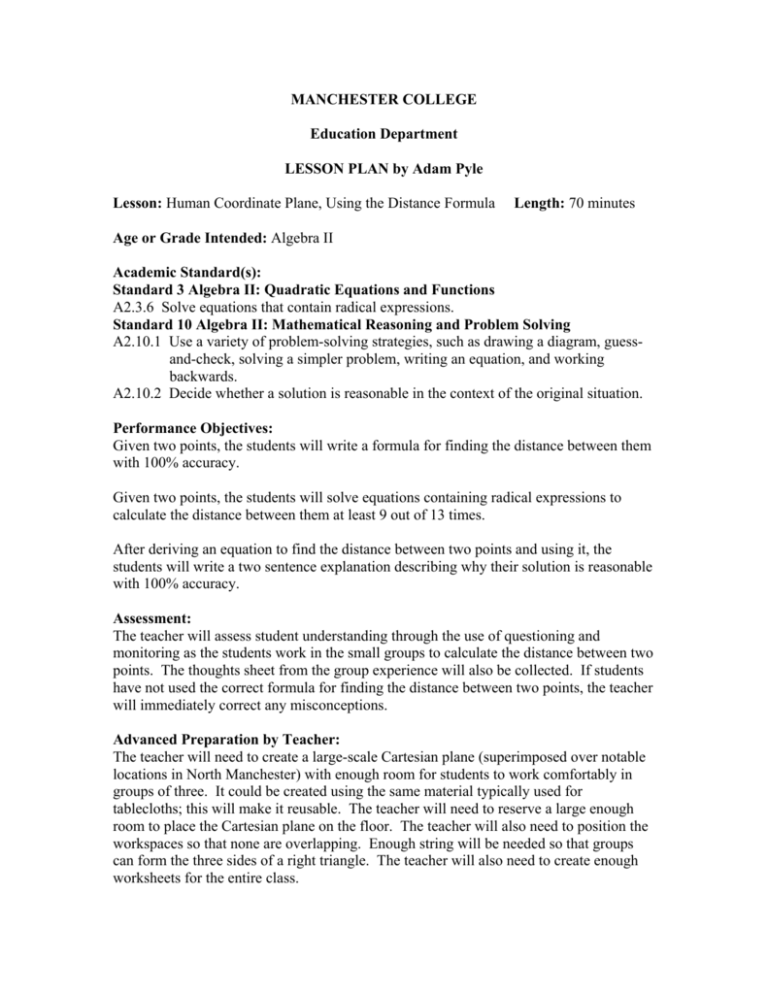
MANCHESTER COLLEGE Education Department LESSON PLAN by Adam Pyle Lesson: Human Coordinate Plane, Using the Distance Formula Length: 70 minutes Age or Grade Intended: Algebra II Academic Standard(s): Standard 3 Algebra II: Quadratic Equations and Functions A2.3.6 Solve equations that contain radical expressions. Standard 10 Algebra II: Mathematical Reasoning and Problem Solving A2.10.1 Use a variety of problem-solving strategies, such as drawing a diagram, guessand-check, solving a simpler problem, writing an equation, and working backwards. A2.10.2 Decide whether a solution is reasonable in the context of the original situation. Performance Objectives: Given two points, the students will write a formula for finding the distance between them with 100% accuracy. Given two points, the students will solve equations containing radical expressions to calculate the distance between them at least 9 out of 13 times. After deriving an equation to find the distance between two points and using it, the students will write a two sentence explanation describing why their solution is reasonable with 100% accuracy. Assessment: The teacher will assess student understanding through the use of questioning and monitoring as the students work in the small groups to calculate the distance between two points. The thoughts sheet from the group experience will also be collected. If students have not used the correct formula for finding the distance between two points, the teacher will immediately correct any misconceptions. Advanced Preparation by Teacher: The teacher will need to create a large-scale Cartesian plane (superimposed over notable locations in North Manchester) with enough room for students to work comfortably in groups of three. It could be created using the same material typically used for tablecloths; this will make it reusable. The teacher will need to reserve a large enough room to place the Cartesian plane on the floor. The teacher will also need to position the workspaces so that none are overlapping. Enough string will be needed so that groups can form the three sides of a right triangle. The teacher will also need to create enough worksheets for the entire class. Procedure: Introduction/Motivation: Ask the students to name some of their favorite locations in North Manchester and make a list of these on the board. Without telling the students how these locations are going to be used in the lesson, explain that everyone will get to represent an ordered pair that day. The goal of the lesson is learning the Distance Formula through discovery (and a bit of geometry). Step-by-Step Plan: 1. Explain the procedures of the group activity: a. Break into groups of three. b. Two of the group members will be designated as particular ordered pairs. For example, student A might be the ordered pair (2, 7) and student B could represent the ordered pair (6, 4). The location of student C will remain a mystery for now. c. The goal of the activity is to find the distance between student A and student B by deciding the best ordered pair location for student C. d. A sheet for collecting thoughts and recording solutions should be completed. 2. After explaining what is going to take place, have the students break into groups of three. Then assign ordered pair locations to two of the students in the group. Distribute the thought sheet at this time as well. 3. Take the students to a room where a large-scale Cartesian plane has been laid on the floor. The Cartesian plane will be superimposed over a map of North Manchester. 4. The students should find their positions on the Cartesian plane and bring along the third group member who has yet to have a location on the map. Reminding the groups of the goal to find the distance between student A and student B, ask the following questions: a. How did you find the distance between two points on the real number line? (Comprehension) b. How might you use similar ideas to find the distance between two points in two-dimensional space? (Analysis) 5. Allow students to quietly discuss possible answers in their small groups. After five minutes of group discussion, give a helpful hint (“Think back to an infamous theorem from your geometry class.”) If a group has figured out a way to calculate the distance between student A and student B, ask them to describe their methods to the larger group. 6. Distribute string to each the groups. Explain that the string can be used to help the students get a visual feeling for the problem. 7. The groups will then complete the thoughts sheet containing the following questions: a. What are the coordinates of A? B? (Comprehension) b. We want to find the distance between A and B. How can we use C to help us do that? (Analysis) c. What familiar geometric shape is formed by drawing line segments between your three points? (Comprehension) d. What famous theorem can we use to find the length of AB or the distance between A and B? (*Hint: you used this theorem in your geometry class) (Comprehension) e. Conjecture a general formula (using your answer to #4) for finding the distance between two points (x1, y1) and (x2, y2). (Synthesis) f. Try your formula with these points. (The teacher can choose two or three examples for the students to work out.) (Application) g. Suppose these distances are going to be used in vital calculations (i.e. construction of an airplane runway, used by a military strategist, etc.). Do your answers seem reasonable? Why or why not? (Evaluation) 8. Have some groups share their responses to question 8 on the worksheet. If the groups do not feel comfortable sharing, ask the following question to spur a reply: a. Think back to your geometry class. What is true about the legs and hypotenuse of a right triangle? (Comprehension) b. How can you use that information to decide upon the reasonableness of your formula? (Analysis) 9. If there are any groups who have not discovered the correct formula, correct this problem at this moment. Show the students the derivation of the Distance Formula and an example where it is used. Closure: Draw and label each of the four conic sections (parabola, circle, ellipse, and hyperbola). Ask the students: • What connections might lie between these conic sections and the Distance Formula? (Analysis) Since no student will likely have a complete answer, explain that each of these conic sections can be described directly in terms of the Distance Formula. The goal of the unit is to discover this connection. Gardner’s Theory of Multiple Intelligences: Interpersonal: Working in teams to derive the Distance Formula and complete the worksheet Visual/Spatial: Working on the coordinate plane to decide an appropriate location for the third student in the group (point C), using string to see the three sides of a right triangle Logical/Mathematical: Solving radical equations, proposing a formula for finding the distance between two points, using the distance formula Bodily/Kinesthetic: Using the students as stand-ins for the ordered pairs Adaptations/Enrichments: Students with Learning Disabilities – Students with a learning disability will be asked to repeat the directions for the teacher as the class walks down to their assigned room. In this lesson the students both embody the role of a coordinate point and are given string to create another visual representation of a right triangle. Both of these will help students with a learning disability retain information because they are encountering the principles behind the Distance Formula in many forms. Students with ADHD – These students will benefit from the physical movements required by this lesson. However, it must remain controlled. Therefore the teacher should periodically check in with the group that contains this student. If it is evident that the student is acting out in ways that are distracting to the rest of the group, the teacher should politely suggest that this student take a quick drink and/or bathroom break. Self-Reflection: These questions will guide my reflection after the lesson has been taught: • Will references to geometry help the students master the concepts underlying the Distance Formula? Are they able to contribute here or have they forgotten much of what they learned in geometry? • Is too much time used through transportation and getting student attention? Will I be able to appropriately assess mastery of the objectives? • Do students feel unimpressed with this exploration of the Distance Formula? How many remembered from geometry and were therefore ready to jump straight into using the formula with actual points? In other words, is it beneficial to explore from where the Distance Formula originates? Names ______________________ ______________________ ______________________ ______________________ Human Coordinate Plane and Distance Formula 1. What are the coordinates of point A? __________ point B? ___________ 2. We want to find the distance between A and B. How can we use C to help us do that? 3. What familiar geometric shape is formed by drawing line segments between your 3 points? __________________ 4. What famous theorem can we use to find the length of AB or the distance between A and B (you probably used this in your geometry class)? _________________________ 5. Use the Pythagorean Theorem to find the distance between your points. 6. Using your answer to #4, conjecture a general formula for finding the distance between two points (x1, y1) and (x2, y2). 7. Try your formula with these points. a. (1, -6) and (7, 2) ⎛ 2 3⎞ ⎛ 7⎞ b. ⎜ , ⎟ and ⎜1, ⎟ ⎝5 5⎠ ⎝ 5⎠ 8. Suppose these calculated distances are going to be used in vital calculations (i.e. construction of an airplane runway, used by a military strategist, etc.). Do your answers seem reasonable? Why or why not?
